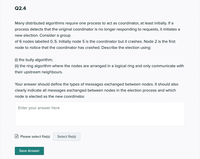
Computer Networking: A Top-Down Approach (7th Edition)
7th Edition
ISBN: 9780133594140
Author: James Kurose, Keith Ross
Publisher: PEARSON
expand_more
expand_more
format_list_bulleted
Question

Transcribed Image Text:Q2.4
Many distributed algorithms require one process to act as coordinator, at least initially. If a
process detects that the original coordinator is no longer responding to requests, it initiates a
new election. Consider a group
of 6 nodes labelled 0..5. Initially node 5 is the coordinator but it crashes. Node 2 is the first
node to notice that the coordinator has crashed. Describe the election using:
(1) the bully algorithm;
(ii) the ring algorithm where the nodes are arranged in a logical ring and only communicate with
their upstream neighbours.
Your answer should define the types of messages exchanged between nodes. It should also
clearly indicate all messages exchanged between nodes in the election process
node is elected as the new coordinator.
which
Enter your answer here
E Please select file(s)
Select file(s)
Save Answer
Expert Solution
This question has been solved!
Explore an expertly crafted, step-by-step solution for a thorough understanding of key concepts.
Step by stepSolved in 2 steps

Knowledge Booster
Similar questions
- This quesiton are for another page I will linked them.arrow_forwarda. b. C. d. e. f. After many insertions and deletions of items to a circular queue; the final status looks like the figure given below: myFront = 4 and myBack = 2 1 myBack 0 X P A D 3 How many items are in the circular queue? What are the items? (Write characters) What is the front item (letter) in the queue? What is the rear item (letter) in the queue? If 'F' is inserted in the existing queue; what will be the value of myBack and myFront? myFront = and myBack = If the front item is removed; myBack? myFront = myFront what will be the value of myFront and and myBack =arrow_forwardCryptographic Data ObjectsB has just received the following message, which represents a cryptographic data object:{({(KPbB)KPrS mod KPbS}K1,{|(NB, NA, {{({K2}KPbB, NS)}(G1)KPrA mod NA}K1, {|{({G3}(KPbA)KPrS mod KPbS, G2)}K1|}KPrB)|}KPrA)}KBSThe following explains various terms in this object and some of the abbreviations used:• {M}K represents the encryption of some message/data M using the key K• {|M|}K represents the digital signing of some message/data M using the key K• NX represents a nonce (i.e. a fresh and possibly random number used once only) generatedby X• KpbX represents the public part of the key pair presumably owned by X• KprX represents the private part of the key pair presumably owned by X• KAB represents a symmetric key shared between A and B• K (or K1, K2, K3 etc.) represents some arbitrary key with no assumptions about its scope• M represents some alphanumeric/textual message with no assumptions• G1, G2, G3 etc. are prime numbersWhich of the following sets of keys,…arrow_forward
- Given a data set x, the following R commands have been run: library(cluster); agnes (x=X)->AG; KPM Match the following objects with what you expect the R output to be. PM$id.med Choose... PM$clustering Choose... AG$order Choose... AG$ac Choose... AG$height Choose... [1] 1, 1, 2, 1, 1, 1, 2 [1] 1, 5, 6, 7, 2, 3, 4 [1] 6, 7 [1] 0.1517008 [1] 4, 4, 4, 4.7948, 4.4721, 4arrow_forwardilg ̟ @ Ahmed Tukmachi صورة الوقت المتبقی 0:07:18 سؤال 1 غیر مجاب عليه بعد الدرجة من 1.00 علم هذا السؤال How many learnable parameters ?are there in the following network model = Sequential() model.add(Conv2D(8, (5,5), activation='relu', input_shape=(28,28,3))) model.add(MaxPooling2D(2,2)) model.add(Conv2D(16, (3,3), activation='relu')) model.add (Flatten()) 1808 744 O 1752 O 1776 O الصفحة التاليةarrow_forwardWe have a poorly-designed hash map where all of the stored values are in one bucket (meaning they're all in one Linked List). Explain why this undermines the advantages of a hash map.arrow_forward
arrow_back_ios
arrow_forward_ios
Recommended textbooks for you
 Computer Networking: A Top-Down Approach (7th Edi...Computer EngineeringISBN:9780133594140Author:James Kurose, Keith RossPublisher:PEARSON
Computer Networking: A Top-Down Approach (7th Edi...Computer EngineeringISBN:9780133594140Author:James Kurose, Keith RossPublisher:PEARSON Computer Organization and Design MIPS Edition, Fi...Computer EngineeringISBN:9780124077263Author:David A. Patterson, John L. HennessyPublisher:Elsevier Science
Computer Organization and Design MIPS Edition, Fi...Computer EngineeringISBN:9780124077263Author:David A. Patterson, John L. HennessyPublisher:Elsevier Science Network+ Guide to Networks (MindTap Course List)Computer EngineeringISBN:9781337569330Author:Jill West, Tamara Dean, Jean AndrewsPublisher:Cengage Learning
Network+ Guide to Networks (MindTap Course List)Computer EngineeringISBN:9781337569330Author:Jill West, Tamara Dean, Jean AndrewsPublisher:Cengage Learning Concepts of Database ManagementComputer EngineeringISBN:9781337093422Author:Joy L. Starks, Philip J. Pratt, Mary Z. LastPublisher:Cengage Learning
Concepts of Database ManagementComputer EngineeringISBN:9781337093422Author:Joy L. Starks, Philip J. Pratt, Mary Z. LastPublisher:Cengage Learning Prelude to ProgrammingComputer EngineeringISBN:9780133750423Author:VENIT, StewartPublisher:Pearson Education
Prelude to ProgrammingComputer EngineeringISBN:9780133750423Author:VENIT, StewartPublisher:Pearson Education Sc Business Data Communications and Networking, T...Computer EngineeringISBN:9781119368830Author:FITZGERALDPublisher:WILEY
Sc Business Data Communications and Networking, T...Computer EngineeringISBN:9781119368830Author:FITZGERALDPublisher:WILEY

Computer Networking: A Top-Down Approach (7th Edi...
Computer Engineering
ISBN:9780133594140
Author:James Kurose, Keith Ross
Publisher:PEARSON

Computer Organization and Design MIPS Edition, Fi...
Computer Engineering
ISBN:9780124077263
Author:David A. Patterson, John L. Hennessy
Publisher:Elsevier Science

Network+ Guide to Networks (MindTap Course List)
Computer Engineering
ISBN:9781337569330
Author:Jill West, Tamara Dean, Jean Andrews
Publisher:Cengage Learning

Concepts of Database Management
Computer Engineering
ISBN:9781337093422
Author:Joy L. Starks, Philip J. Pratt, Mary Z. Last
Publisher:Cengage Learning

Prelude to Programming
Computer Engineering
ISBN:9780133750423
Author:VENIT, Stewart
Publisher:Pearson Education

Sc Business Data Communications and Networking, T...
Computer Engineering
ISBN:9781119368830
Author:FITZGERALD
Publisher:WILEY